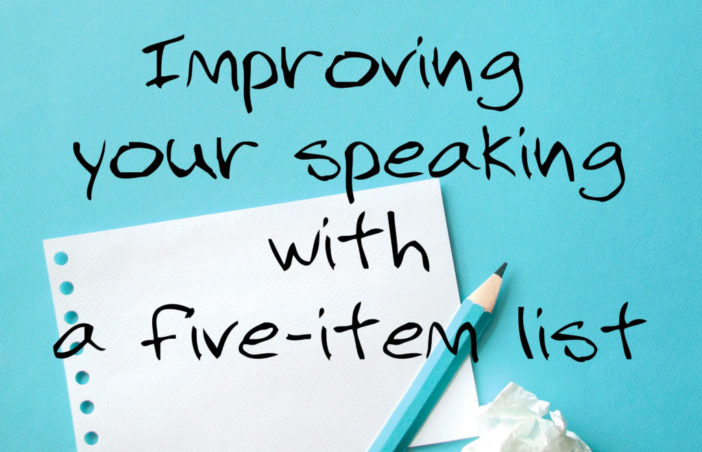Improving your speaking with a five-item list
Recently I was listening to a psychology lecture by Professor Mark Leary on my favorite video learning site, Great Courses Plus. In discussing how our mind works, he pointed out that talking is almost completely nonconscious (psychologists prefer this term to unconscious): that is, we don’t consciously choose our words when we speak. Words usually come out of our mouths without our really thinking about what we’re saying. We make a conscious effort to choose the right words only in special situations … like when we’re being interviewed or when we have to discuss a sensitive issue with a friend or colleague.
I believe that nonconscious talking is really the same as language fluency. As a fluent speaker of our native language, we can easily talk nonconsciously. But when we’re trying to speak another language, we become all too conscious of what we’re saying.
When we first learn a language, we’re hyper-conscious (that’s my made-up word to mean very, very conscious). We struggle with pronunciation, grammatical forms, vocabulary, putting sentences together. As our fluency improves, our speaking becomes more nonconscious; we are able to speak more quickly, about lots of different topics.
On the other hand, in certain stressful situations, we may return to being more hyper-conscious … we speak with more pauses and hesitations and may repeat what we have just said to make sure we got it right (this is probably why test-takers often do worse on the TOEFL Speaking section).
Unfortunately, as we progress in our language learning, we often pick up bad habits. We get in the habit of making a particular error and repeat it without being aware of the mistake. These errors become, in fact, nonconscious. We don’t notice them and, thus, we don’t correct them. To make matters worse, when we repeat a particular behavior, it becomes embedded (set, planted, rooted) in our brain. And once our brains are wired to make this mistake, it’s difficult to change. Just like any bad habit, it’s very hard to break.
In addition, there are certain expressions, or structures, or phrases that we find difficult to use fluently and nonconsiously. For example, we have problems with using he and she, or with adding the final -s in the third-person singular present tense. We may be able to proceed along in a conversation quite fluently, and then have to pause while we think about how to say something correctly.
So how do we get out of this rut and re-wire (re-train) our brain to avoid making the same mistakes and to become more nonconscious in our speaking?
I suggest using a five-item list. Here’s how it works.
- Start your list with one expression/structure/phrase that causes you problems — either because you have picked up a bad habit or because you tend to hesitate and think consciously about how to say it correctly. I recently had a student who repeatedly said “do mistakes” rather than “make mistakes.” When I pointed this out, she said she knew that she should say “make mistakes” but she’d gotten in the habit of using “do mistakes” instead. Since we’d identified this as a phrase that she used fairly frequently, I suggested that she start her list with this expression, along with a few others that are similar: make errors, make decisions, make choices.
- Once you have an item on your list, practice this expression/structure/phrase regularly, in a variety of ways. For example, my student with the bad habit could repeat a number of made-up sentences like these:
I make mistakes in English.
I made a mistake yesterday.
Making mistakes is common.
I want to avoid making mistakes.
Or, my student who has problems with conditionals could “fill-in-the-blanks” like this:
If I had ——, I would ——- (a certainty)
If I had ——, I could ——– (a possibility)
He could then extend this practice by replacing had with other past tense verbs (like went or saw)
- Your goal for each item is to replace your bad habit with a good habit or to use this particular expression/structure/phrase without hesitation. You will know you have succeeded when you are speaking nonconsciously and you say something like, “I always make a mistake” instead of “I always do a mistake.”
- As you encounter other common items that have become bad habits or cause you to hesitate, add them to your list. Don’t go over five items at one time. When you feel you’ve really mastered something (so that, for example, you say “make mistakes” without giving it any thought), then cross that item off your list.
- Remember that this is a method to re-wire your brain and correct bad habits that have become unconscious. At the same time, to improve your fluency, you’ll also be acquiring new information, like new vocabulary words or new irregular past tense verb forms. By combining both strategies, you will make quicker progress toward becoming a fluent English speaker.





